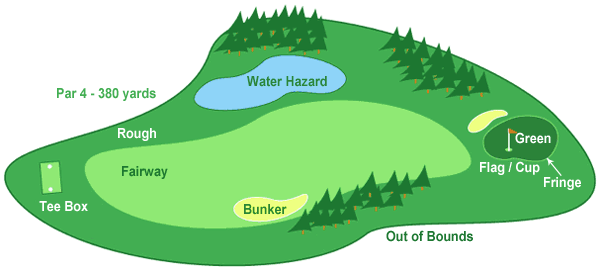Week Three: Chipping
Students will be able to:
learn the difference between putting and chipping
learn about club selection in chipping and ball position/stance
learn how to choose a target
apply chipping drills to improve chipping skills
participate in an up-and-down competition
learn about the teeing ground, parts of the golf course, and honors
define sportsmanship
Week 3 Notes:
Chapter 3 Rules: Parts of the Golf Course
a. Parts of the golf course (see below)
b. Teeing Ground- the starting point of the golf hole
The teeing ground is composed of several tee boxes, usually some variation of black, gold, blue, white, red, and green. Each tee box has two tee markers, and these markers, which are always colored, define where you may tee up the ball. The tee box farthest from the hole has black tee markers, and is called “the tips”.
You may tee the ball up to two club-lengths behind the tee markers. This means you cannot tee up the ball in front of the markers, more than two club-lengths behind the markers, or outside the markers. To clarify on the last point, you can stand outside of the markers, but the ball itself must lie between the two markers. The penalty for breaking this rule is two strokes.
If a ball, when not in play, falls off a tee or is knocked off by the player while addressing it, it may be re-teed without penalty. But if the player intended to strike the ball, then a stroke was made and the stroke counts but no penalty is incurred.
Addressing the ball means you have taken your stance. Intending to hit the ball means you have already taken your stance and are now going to hit the ball. The ball is in play once you have intention to hit it.
c. Honors in golf is etiquette (you cannot be penalized for playing out of order). Whoever gets the lowest score on a hole goes first on the next hole. If players tie, whoever went first on the last hole goes first again. There is no policy as to who goes first on the first hole, but often we flip a tee or play alphabetically.
Lesson: Ball Position and Club Selection in Chipping
Ball position affects loft. In chipping, we position the ball towards the back foot because we want the ball to roll more and fly less. If you move the ball back in your stance, the club angle decreases.
We use an iron in chipping because irons have more loft than putters and less loft than wedges. A 9- or 8-iron has more loft than a 7- or 6-iron. If you are farther from the hole, you should use a lower lofted iron (7 or 6). If you are closer to the hole, you should use a higher lofted iron (9 or 8).
The rule of 12: if the hole is at a distance of 12 feet…each foot would be “one part”. You want the club you use to land that many “parts” away from you, while using a putting style stroke to your swing. If you’re using a 6-iron, you would want it to land six parts away, or six feet in this case. According to the rule, it would then roll the remaining parts. A PW would land 10 parts away, and roll the remaining two. A 3-iron, three parts away and rolling the remaining nine.
Whichever club you use, equate that to the parts the ball should fly. The remaining parts would be the roll. A 48 foot chip with a 5-iron? You are going to carry it 20 feet (5 parts), and it should roll out the remaining 28 feet (7 parts).
Up-and-down: this is when you chip or pitch the ball to the green, within 3 feet, and putt the ball in. This equates to two total strokes. An up-and-down is similar to a 2-putt. Your goal is to only use up two strokes per hole and short game (putting, chipping, or pitching).
Practice: Chipping and putting
Practice chipping with different clubs (9-, 8-, 7-iron, and putter). Practice up-and-downs with chipping: chip and then 1-putt.
Video: Up and down, Order of Play
Parts of the Golf Course

